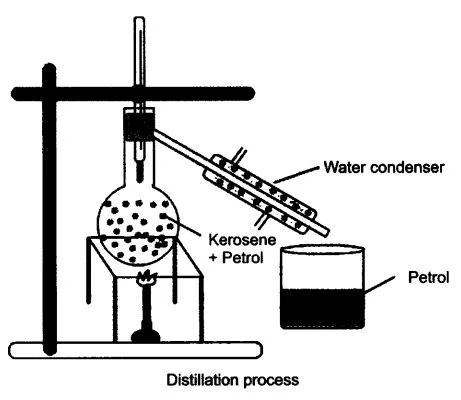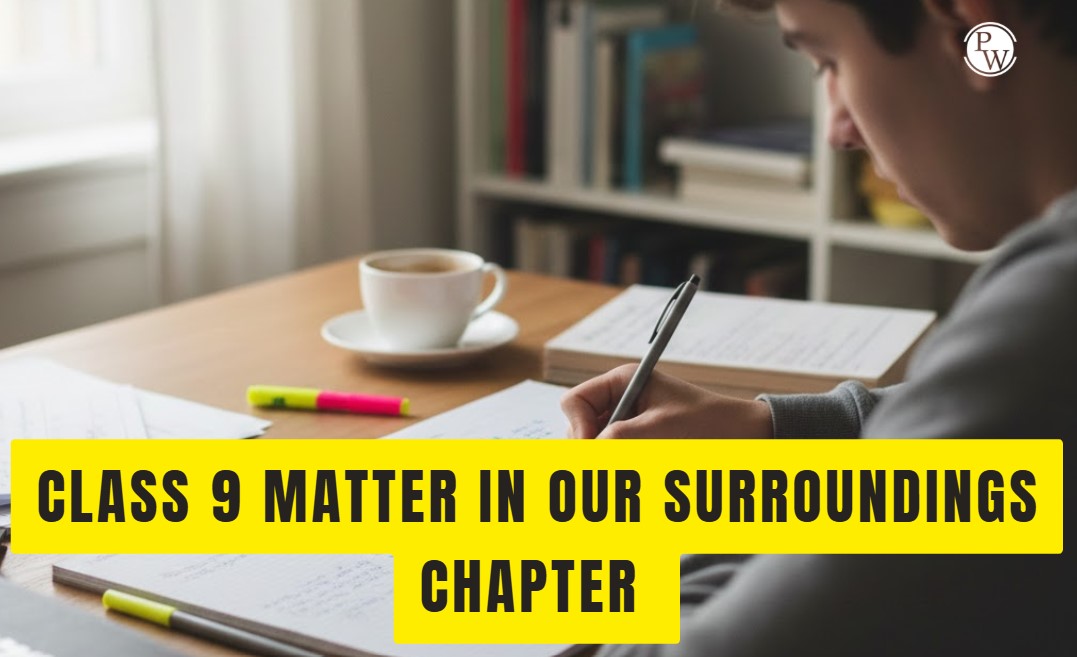
Chapter 2 of Class 9 Science, “Is Matter Around Us Pure?”, explains that matter is made up of substances that can be pure or mixed with others.
It talks about different types of mixtures like solutions, colloids, and suspensions. The chapter also teaches how we can separate the parts of a mixture using methods like filtration and distillation.
NCERT Solutions for Class 9 Science Chapter 2
NCERT Class 9 Science Chapter 2 focuses on the structure of matter, covering topics like atoms, molecules, and the laws of chemical combination.
NCERT Solutions for Class 9 Science Chapter 1
NCERT Solutions Class 9 Chapter 2 Science Question Answer
NCERT Solutions Class 9 Chapter 2 Science Question Answer provides detailed and accurate answers to all the questions in Chapter 2, “Is Matter Around Us Pure?”. The solutions explain different types of mixtures such as solutions, colloids, and suspensions. These answers help students prepare effectively for exams with step-by-step explanations.
Question 1. What is meant by a substance?Solution : Substance can be defined as that kind of matter where constituent particles cannot be separated from each other by any physical process since they are all similar in chemical properties.
Question 2. List the points of differences between homogeneous and heterogeneous mixtures.Solution :

Solution :

Question 4. How are sol, solution and suspension different from each other?
Solution :

Solution :
Mass of sodium chloride (solute) = 36 g Mass of water (solvent) = 100 g Mass of solution = 36 + 100 = 136 g Therefore, concentration percentage = mass of solute/mass of solution = 26.47 % Question 6. How will you separate a mixture containing kerosene and petrol (difference in their boiling points is more than), which are miscible with each other?Solution : We can separate a mixture containing kerosene and petrol by distillation technique since difference in their boiling points is more than. So through distillation we can get them separated.
Question 7. Name the technique to separate (i) butter from curd, (ii) salt from sea-water, (iii) camphor from salt.Solution :
(i) centrifugation method. (ii) evaporation method. (iii) sublimation method. Question 8. What type of mixtures are separated by the technique of crystallisation?Solution : From impure samples of solids, pure solid crystals can be obtained by the method of crystallization for eg to obtain pure sugar from impure sample of the same.
Question 9. Write the steps you would use for making tea. Use the words solution, solvent, solute, dissolve, soluble, insoluble, filtrate and residue.Solution : Take more amount of solvent (water) in a pan and after heating it add little amount of solute (sugar) to the solvent. Solute will dissolve completely in the solvent forming true solution, then add tea leaves that are insoluble along with another soluble liquid milk. After boiling allow filtration with a sieve so the filtrate you obtain is tea while the residue has tea leaves that are thrown away.
Question 10. Classify the following as chemical or physical changes : • cutting of trees, • melting of butter in a pan, • rusting of almirah, • boiling of water to form steam, • passing of electric current, through water and the water breaking down into hydrogen and oxygen gases, • dissolving common salt in water, • making a fruit salad with raw fruits, and • burning of paper and wood.Solution :
cutting of trees = chemical change melting of butter in a pan = physical change rusting of almirah = chemical change boiling of water to form steam = physical change passing of electric current, through water and the water breaking down into hydrogen and oxygen gases = chemical change dissolving common salt in water = physical change making a fruit salad with raw fruits = physical change burning of paper and wood = chemical change Question 11. Try segregating the things around you as pure substances or mixtures.Solution :
Pure substance: Water, salt, sugar Mixture: Saltwater, soil, wood, air, cold drink, rubber, sponge, fog, milk, butter, clothes, food Question 12. Which separation techniques will you apply for the separation of the following? (a) Sodium chloride from its solution in water. (b) Ammonium chloride from a mixture containing sodium chloride and ammonium chloride. (c) Small pieces of metal in the engine oil of a car. (d) Different pigments from an extract of flower petals. (e) Butter from curd. (f) Oil from water. (g) Tea leaves from tea. (h) Iron pins from sand. (i) Wheat grains from husk. (j) Fine mud particles suspended in water.Solution :
(a) Evaporation (b) Sublimation (c) Filtration (d) Chromatography (e) Centrifugation (f) Separating funnel (g) Filtration (h) Magnetic separation (i) Winnowing/ sedimentation (j) Decantation and filtration Question 13. How will you separate a mixture containing kerosene and petrol (difference in their boiling points is more than 25°C), which are miscible with each other?Solution : A mixture of kerosene and petrol which are miscible with each other can be separated by distillation. Method
 • Take a mixture in a distillation flask. • Fit it with a thermometer. • Arrange the apparatus as shown in the figure. • Heat the mixture slowly. • Petrol vaporises first as it has lower boiling point. It condenses in the condenser and is collected from the condenser outlet. • Kerosene is left behind in the distillation flask. Question 14. Pragya tested the solubility of three different substances at different temperatures and collected the data as given below( results are given in the following table, as grams of substance dissolved in 100 grams of water to form a saturated solution).
• Take a mixture in a distillation flask. • Fit it with a thermometer. • Arrange the apparatus as shown in the figure. • Heat the mixture slowly. • Petrol vaporises first as it has lower boiling point. It condenses in the condenser and is collected from the condenser outlet. • Kerosene is left behind in the distillation flask. Question 14. Pragya tested the solubility of three different substances at different temperatures and collected the data as given below( results are given in the following table, as grams of substance dissolved in 100 grams of water to form a saturated solution).
| Substance dissolved | Temperature in K | ||||
| 283 | 293 | 313 | 333 | 353 | |
| Potassium nitrate | 21 | 32 | 62 | 106 | 167 |
| Sodium chloride | 36 | 36 | 36 | 37 | 37 |
| Potassium chloride | 35 | 35 | 40 | 46 | 54 |
| Ammonium chloride | 24 | 37 | 41 | 55 | 66 |
Solution :
(a) At 313 K, 62 grams of Potassium nitrate dissolved in 100 grams of water. So to produce a saturated solution of potassium nitrate in 50 grams of water, we need 62 x 50 = 31 grams of potassium nitrate 100 (b) Some soluble potassium chloride will separate out in the form of crystals at room temperature because the solubility of potassium chloride will decrease with decrease in temperature. (c) (i) Solubility of Potassium nitrate at 293 K is 32 grams. (ii) Solubility of Sodium chloride at 293 K is 36 grams. (iii) Solubility of Potassium chloride at 293 K is 35 grams. (iv) Solubility of Ammonium chloride at 293 K is 37 grams. The solubility of Ammonium chloride is highest at this temperature. (d) The solubility of salt increases with increase in temperature. Question 15. Explain the following giving examples. (a) saturated solution (b) pure substance (c) colloid (d) suspensionSolution :
(a) saturated Solution :- It is a solution in which no more solute particles can be dissolved at a particular temperature.
(b) pure substance :- Such substance that has a uniform composition i.e. has particles with identical properties is called pure substance eg sugar, salt, water, nitrogen etc.
(c) Colloid :- A colloid is a heterogeneous mixture. The size of the solutes in this mixture is so small that they cannot be seen individually with naked eyes, and seems to be distributed uniformly throughout the mixture. The solute particles do not settle down when the mixture is left undisturbed. This means that colloids are quite stable. Colloids cannot be separated by the process of filtration. They can be separated by centrifugation. Colloids show the Tyndall effect. For example, milk, butter, foam, fog, smoke, clouds.
(d) Suspension :- Suspensions are heterogeneous mixtures. The solute particles in this mixture remain suspended throughout the bulk of the medium. The particles can be seen with naked eyes. Suspension shows the Tyndall effect. The solute particles settle down when the mixture is left undisturbed. This means that suspensions are unstable. Suspensions can be separated by the method of filtration. For example, mixtures of chalk powder and water, wheat flour and water.
Question 16. Classify each of the following as a homogeneous or heterogeneous mixture. soda water, wood, air, soil, vinegar, filtered tea.Solution :
Homogeneous mixtures: Soda water, air, vinegar Heterogeneous mixtures: Wood, soil, filtered teaSolution : If we allow the given liquid to evaporate by heating it as in a clean china dish so:
O any residue remaining in the china dish will indicate that water is not pure but contains impurities. O no residue in china dish will indicate that water is pure.Solution : Pure substances are: ice, iron, hydrochloric acid, calcium oxide, mercury.
Question 19. Identify the solutions among the following mixtures.Solution : Sea water, air and soda water are solutions.
Question 20. Which of the following will show “Tyndall effect”?Solution : Milk and starch solution have larger particles since they are not true solutions so they will show tyndall effect.
Question 21. Classify the following into elements, compounds and mixtures. (a) Sodium (b) Soil (c) Sugar solution (d) Silver (e) Calcium carbonate (f) Tin (g) Silicon (h) Coal (i) Air (j) Soap (k) Methane (l) Carbon dioxide (m) BloodSolution :
Elements :| (a) Sodium |
| (d) Silver |
| (f) Tin |
| (g) Silicon |
| (e) Calcium carbonate |
| (k) Methane |
| (l) Carbon dioxide |
| (b) Soil |
| (c) Sugar solution |
| (h) Coal |
| (i) Air |
| (j) Soap |
| (m) Blood |
Solution :
The following changes are chemical changes: (a) Growth of a plant (b) Rusting of iron (d) Cooking of food (e) Digestion of food (g) Burning of candleNCERT Solutions Class 9 Science Chapter 2 FAQs
Why is understanding 'Matter around Us - Pure' essential in Class 9 Science?
What topics are covered in NCERT Class 9 Science Chapter 2?
Are NCERT Solutions sufficient for mastering Chapter 2 of Class 9 Science?
How can I effectively study 'Matter around Us - Pure' for exams?
Can I access detailed explanations and step-by-step solutions in NCERT Solutions?










